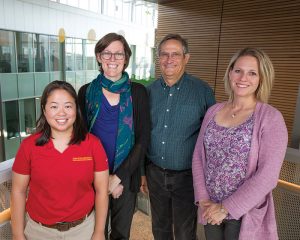
Interdisciplinary team uses systems approach to sequence microbial genes
Historically, treatments for disease-causing microorganisms have relied heavily on the use of antimicrobial drugs.
Adina Howe says this very practice (both when it’s used properly and when it’s misused), along with naturally occurring phenomena, has accelerated how quickly microorganisms are evolving into resistant strains.
“If we continue to see bacteria, fungi, viruses and parasites increasingly becoming resistant to antimicrobial drugs, common treatments for infections and minor injuries will become ineffective,” explains Howe, an assistant professor of agricultural and biosystems engineering.
She adds that other factors, like poor infection control practices, inadequate sanitary conditions and inappropriate food handling, can encourage the spread of antimicrobial resistance.
To better understand antimicrobial resistance and how it enters the environment and food chain, Howe is leading a research team that is studying the phenomenon in agricultural environments.
The multidisciplinary group, which includes Michelle Soupir, an associate professor of agricultural and biosystems engineering at Iowa State, Heather Allen and Tom Moorman from USDA’s Agricultural Research Service, and Shannon Hinsa, an associate professor of biology at Grinnell College, recently received a nearly $1 million, three-year grant from the U.S. Department of Agriculture’s National Institute of Food and Agriculture.
The group will be using a systems approach in its research, adding insight from engineering, microbiology, soil science and health experts.
Iowa State’s team is working to improve a technology that Howe designed to efficiently sequence the genes of microbes. The tool, called DARTE-QM, will allow the group to hone in microbial resistant gene reservoirs in the environment.
To begin its work, the team is studying manure, soil and water samples gathered from swine operations.
“Using DARTE-QM, we can take DNA from the environment and look at its fingerprint to identify bacteria and which genes might allow antimicrobial resistance to develop. We can target hundreds of resistant genes at the same time,” Howe explains.
The group will also consider environmental factors, like production practices or weather-related occurrences, as it studies where antimicrobial resistance occurs and why it continues.
Howe says the group also studies various strategies to mitigate the emergence, spread and persistence of antimicrobial pathogens, and that this endeavor absolutely requires input from multiple disciplines and perspectives. Currently, the team is evaluating the effectiveness of various manure storage strategies and their impact on reducing resistant bacteria.
“If everyone on this team wasn’t participating in this project, there’s no way we would be able to accomplish our goals,” Howe says. “It’s a whole team of dedicated, hardworking people who bring their expertise to solve a very challenging problem. The end result will be a better understanding of how resistance develops and how we might reduce it.”